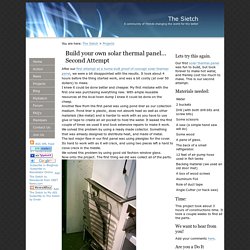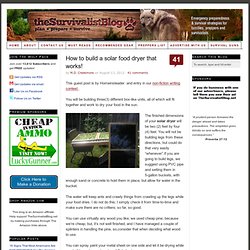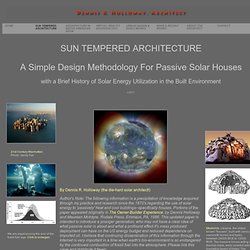

Plans for Passive Solar Homes. Welcome to The Sietch - Projects Build Your Own Solar Thermal Panel. After our first attempt at a home built proof of concept solar thermal panel, we were a bit disappointed with the results.

It took about 4 hours before the thing started work, and was a bit costly (at over 50 dollars) to make. I knew it could be done better and cheaper. My first mistake with the first one was purchasing everything new. With ample reusable resources at the local town dump I knew it could be done on the cheap. Another flaw from the first panel was using pond liner as our collection medium. We solved this problem by using a ready made collector. The last major flaw in our first panel was using plexiglas for the cover. We solved this problem by using good old fashion window glass. Now onto the project. Our local dump has a coolant removal program that has refrigerators and dehumidifiers that they remove old freon from. Make sure that the freon, or other coolant has been removed, and cut the grill off at the base, near the large coolant holder. How to build a solar food dryer that works! This guest post is by Homeinsteader and entry in our non-fiction writing contest .

You will be building three(3) different box-like units, all of which will fit together and work to dry your food in the sun. The finished dimensions of your solar dryer will be two (2) feet by four (4) feet. You will not be building legs from these directions, but could do that very easily “whenever”.If you are going to build legs, we suggest using PVC pipe and setting them in 5-gallon buckets, with enough sand or concrete to hold them in place, but allow for water in the bucket.
The water will keep ants and crawly things from crawling up the legs while your food dries. I do not do this; I simply check it from time-to-time and make sure there are no critters; so far, so good. You can use virtually any wood you like; we used cheap pine, because we’re cheap; but, it’s not well finished, and I have managed a couple of splinters in handling the pine, so,consider that when deciding what wood to use.
7th Grader mimics Nature. 13 year old copies Nature to Improve Solar Performance Thirteen year old Aidan Dwyer was walking in the woods in Upstate New York in the winter and noticed a spiral pattern to tree branches.

Aidan realized the tree branches and leaves had a mathematical spiral pattern that could be shown as a fraction. After some research he also realized the mathematical fractions were the same numbers as the Fibonacci sequence. "On the oak tree, the Fibonacci fraction is 2/5, which means that the spiral takes five branches to spiral two times around the trunk to complete one pattern. Other trees with the Fibonacci leaf arrangement are the elm tree (1/2); the beech (1/3); the willow (3/8) and the almond tree (5/13) Aidan's backyard in Northport, NY.
Free-Energy Devices, zero-point energy, and water as fuel. Backwoods Solar Electric Systems. A Simple Design Methodology For Passive Solar Houses. Designing a Passive Solar House When the term, "passive solar" was introduced into the language of professional solar researchers in the 1970's, most people didn't have a vague notion what it meant.

Later, as the term was popularized by the media and through a large number of public educational conferences, people probably thought that if they wanted to build a passive solar house they would have to hire not only an architect, but a professional solar engineer capable of manipulating very complex mathematical equations on a computer. Today, thanks primarily to knowledge gained from government-funded research on a large number of completed "pioneer" passive solar houses, we've collected data in the late 1970s, and are at the stage where even a high school student can design a passive solar structure. Following is a composite of recently published information to get the owner-builder on the path to owner-designing the passive solar house.